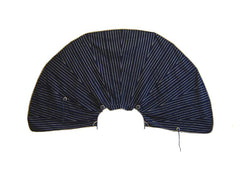An Indigo Dyed Cotton Kappa: Traveling Cape
ca. late nineteenth century
35" x 87", 89 cm x 221 cm
This is a traveling cape and it is very much emblematic of the late Edo and Meiji eras.
Called kappa (borrowed from the Portuguese) or a bozukappa (Buddhist priest of monk cape) these capes were made as a protection from wind and rain and were usually laminated thusly: a layer of paper was placed between the lining and the exterior of the cape: not only did the paper provide more resistance to the elements, it also created a nice, rustling sound.
This kappa is devoid of the paper lining. However, it is made of 18 wedge-shaped indigo dyed cotton pieces (36 if you count the lining and exterior) and the large, crescent shape is quite luxurious. It is voluminous in size.
There is some unraveling to the applied edging material, and there is a slight burn mark to the exterior, which can be seen on detail photos: the burn is just to the left of the proper, left hand circular closure piece.
Kappa are quite collectible, often for the more "deluxe" versions that are created from a variety of kasuri cottons, which gives a subtle and rich look to this old fashioned garment.
Recommended.

